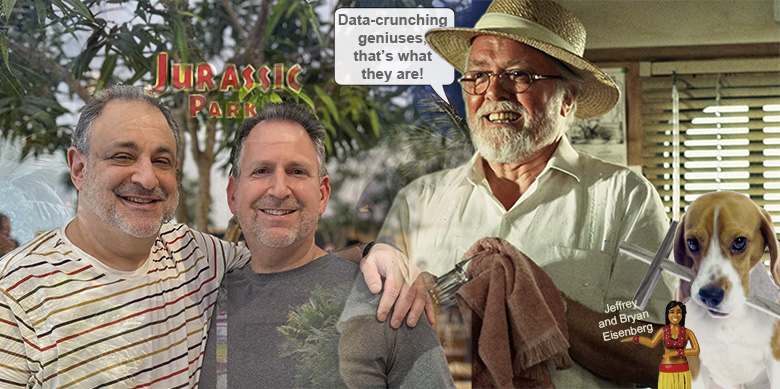Do you remember that scene in Jurassic Park when the park’s founder revealed that he had extracted the blood of a dinosaur from a mosquito trapped in fossilized tree sap?
Forget the blood. Forget the dinosaur. Our interest is in that mosquito trapped in amber.
I sometimes think time is the amber in which we mosquitoes are held captive.
As Edwin Abbot demonstrated in his breakthrough book, “Flatland: A Romance of Many Dimensions,” we live in 4 dimensions: Height, Width, Depth, and Time. We have access to the 3 lower dimensions, but no access to the 7 dimensions in M-Theory that lie above and beyond our 4-dimensional “spacetime continuum.”
According to theoretical physicists, those 7 dimensions are as real as the 4 in which we live. And here is the interesting part: beings in those dimensions are outside of time. They are above it. We, however, are like those mosquitoes trapped in amber. Time does not expand us; it inhibits us, shackles us, makes us wear blinders that keep us from observing things that are happening in the dimensions above us. This would seem to confirm the idea that we are not physical beings who occasionally have a spiritual experience, but spiritual beings who are having a temporary physical experience.
You might be wondering what catapulted my mind into this strange, metaphysical sky this morning, so I will tell you. My partner Craig Arthur lives in Townsville, Australia, where his winter is our summer and his night is our day. This gives Craig and me a brief window to chat when he is ending his day and I am beginning my own.
This morning I opened my laptop just as Craig forwarded a meme from Cat Damon. It said,
“My son just walked into my room and said, ‘Daddy, I’m scared to die. Not of going to hell, I don’t think there is such a place, but I guess I’m scared there’s nothing. There was nothing before, so what if there’s nothing after?'”
Cat Damon wraps up his story with these words,
“My son is 37 years old and on acid.”
I’m not on acid. My drug of choice is called “Speculation.” You make it by combining Knowledge and Intuition in equal parts. Stirring this mixture is not required. Speculation explodes into existence when the two ingredients make contact.
Speculation is susceptible to confirmation bias, of course. We quickly see confirmation of what we already believe.
There is another formula, more popular than my own, that is just as susceptible to confirmation bias, though its practitioners like to believe their formula is objective, reliable, and scientific. This more popular formula is “Knowledge plus Data.”
Am I against data? Of course not. But I can tell you that the most skillful users of data – people like Sean Jones, Dewey Jenkins, Cedric Yau, Vi Wickam, Gene Naftulyev, Pyotr Belov, Jeffrey and Bryan Eisenberg, John Quarto von Tivadar, and Luis Castañeda – these people always ask themselves whether the data might be indicating something other than what they saw at first glance.
But most people do not question their initial interpretation of data. In the words of Andrew Lang, they use data, “like a drunk man uses a lamp post – for support rather than illumination.”
Knowledge + Intuition = Speculation
Knowledge + Data = Speculation
My observation has been that these 2 formulas are really just 2 different paths that lead to precisely the same destination. The key that unlocks the golden door of miracles is to have an independent partner who is using the formula you are NOT using. When both of you arrive at the same conclusion – even though you came at it from different directions – you can be far more confident that you have found the answer you were seeking.
Data is a snapshot of reality expressed in numbers in a database or on a spreadsheet. Data is the logic of the rational, sequential, deductive reasoning left hemisphere of your brain.
Intuition is a snapshot of reality expressed in similes, metaphors, and instincts. It is the logic of the wordless, pattern-finding right hemisphere of your brain.
Data can be gathered and processed by the latest and greatest AI, artificial intelligence.
Intuition is gathered and processed by the original AI, actual intelligence.
One uses chips and processors. The other uses neurons and synapses.
These are the things that were triggered in my mind when my partner Craig sent me a meme this morning.
Roy H. Williams
 Joanne Lipman was the first woman to become a deputy managing editor at The Wall Street Journal. She was the founding editor-in chief-of Condé Nast’s Portfolio magazine. She served as editor-in-chief of USA Today and chief content officer of its parent company, Gannett. Currently, Joanne is a regular contributor to CNBC and a lecturer at Yale University. In her latest book — garnering blockbuster reviews — Joanne provides numerous examples of people who reinvented themselves. Listen in as she tells roving reporter Rotbart precisely how anyone can make the successful leap from one career to the next, and then the next and the next after that. Who? What? Where? MondayMorningRadio.com.
Joanne Lipman was the first woman to become a deputy managing editor at The Wall Street Journal. She was the founding editor-in chief-of Condé Nast’s Portfolio magazine. She served as editor-in-chief of USA Today and chief content officer of its parent company, Gannett. Currently, Joanne is a regular contributor to CNBC and a lecturer at Yale University. In her latest book — garnering blockbuster reviews — Joanne provides numerous examples of people who reinvented themselves. Listen in as she tells roving reporter Rotbart precisely how anyone can make the successful leap from one career to the next, and then the next and the next after that. Who? What? Where? MondayMorningRadio.com.
